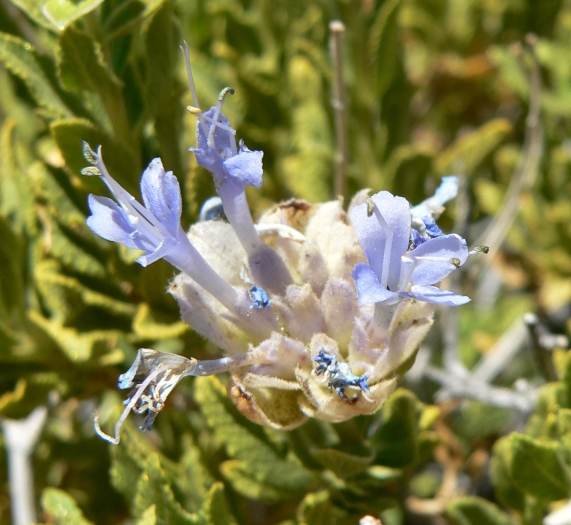Mojave Sage
(Salvia mohavensis)
Mojave Sage (Salvia mohavensis)
/
/

Stan Shebs
CC BY-SA 3.0
Image By:
Stan Shebs
Recorded By:
Copyright:
CC BY-SA 3.0
Copyright Notice:
Photo by: Stan Shebs | License Type: CC BY-SA 3.0 | License URL: https://creativecommons.org/licenses/by-sa/3.0 | Uploader: Stan Shebs | Publisher: Wikimedia Commons | Title: Salvia_mohavensis_3.jpg | Notes: {{Information |Description ={{en|1=Salvia sclarea - S. Agata Fossili, Alessandria, Italy}} |Source ={{own}} |Author =[[User:Ettore Balocchi|Ettore Balocchi]] |Date =2008-06-20 |Permission = |other_versions = }} [[Category |


























Estimated Native Range
Summary
Salvia mohavensis, commonly known as Mojave Sage, is an evergreen shrub or subshrub native to the Mojave and Sonoran Deserts. It thrives in arid environments, often found on dry slopes and in desert washes where it is adapted to the extreme heat and drought conditions. Mojave Sage typically grows to about 1 meter tall and wide, with small, opposite evergreen leaves that are 1.5–2 cm long. The foliage is dark green, often appearing nearly gray due to a covering of fine white hairs that help reflect sunlight and conserve moisture. The flowers, which are pale blue and about 2 cm long, have protruding stamens and are arranged in headlike whorls at the stem tips. They bloom from April to June and are quite showy, attracting pollinators such as bees and hummingbirds.
Mojave Sage is valued for its drought tolerance and its ability to thrive in hot, dry climates, making it an excellent choice for xeriscaping and water-wise gardens. It is also used for habitat restoration projects within its native range. In cultivation, it requires full sun and well-drained soils, and once established, it has low water needs. While it is generally low-maintenance, it can be pruned to maintain a compact form. Mojave Sage is not known for having aggressive roots or significant disease problems, but it can be susceptible to root rot if overwatered. It is not typically invasive when grown outside its native range, but gardeners should always check local guidelines as conditions can vary.CC BY-SA 4.0
Mojave Sage is valued for its drought tolerance and its ability to thrive in hot, dry climates, making it an excellent choice for xeriscaping and water-wise gardens. It is also used for habitat restoration projects within its native range. In cultivation, it requires full sun and well-drained soils, and once established, it has low water needs. While it is generally low-maintenance, it can be pruned to maintain a compact form. Mojave Sage is not known for having aggressive roots or significant disease problems, but it can be susceptible to root rot if overwatered. It is not typically invasive when grown outside its native range, but gardeners should always check local guidelines as conditions can vary.CC BY-SA 4.0
Plant Description
- Plant Type: Shrub, Subshrub
- Height: 2-3 feet
- Width: 2-3 feet
- Growth Rate: Moderate
- Flower Color: Blue
- Flowering Season: Fall, Spring
- Leaf Retention: Evergreen
Growth Requirements
- Sun: Full Sun
- Water: Low, Medium
- Drainage: Fast
Common Uses
Bee Garden, Bird Garden, Butterfly Garden, Deer Resistant, Drought Tolerant, Fragrant, Hummingbird Garden, Low Maintenance, Rabbit Resistant, Showy Flowers
Natural Habitat
Native to the Mojave and Sonoran Deserts
Other Names
Common Names:
Scientific Names: , Salvia mohavensis, Audibertia capitata, Audibertiella capitata, Ramona capitata, Salvia nohavensis,
GBIF Accepted Name: Salvia mohavensis Greene